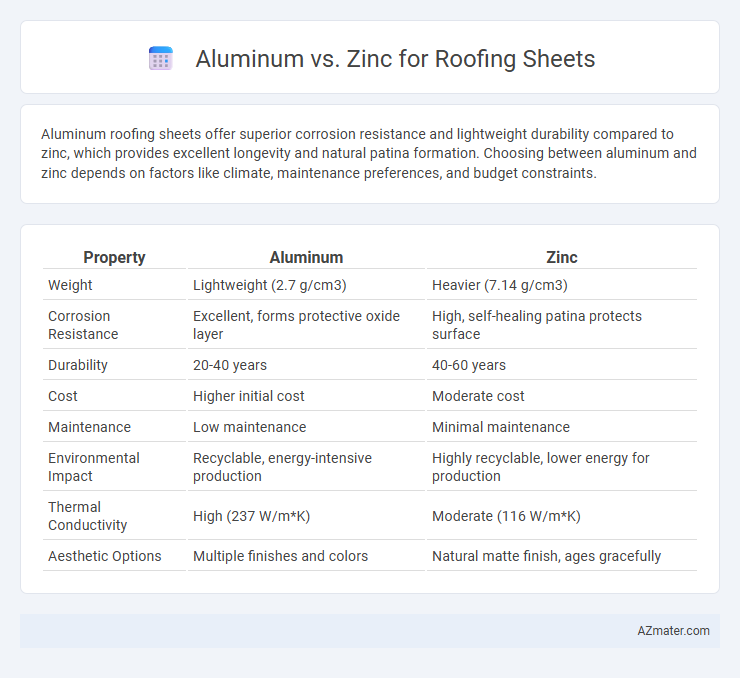Aluminum roofing sheets offer superior corrosion resistance and lightweight durability compared to zinc, which provides excellent longevity and natural patina formation. Choosing between aluminum and zinc depends on factors like climate, maintenance preferences, and budget constraints.
Table of Comparison
| Property | Aluminum | Zinc |
|---|---|---|
| Weight | Lightweight (2.7 g/cm3) | Heavier (7.14 g/cm3) |
| Corrosion Resistance | Excellent, forms protective oxide layer | High, self-healing patina protects surface |
| Durability | 20-40 years | 40-60 years |
| Cost | Higher initial cost | Moderate cost |
| Maintenance | Low maintenance | Minimal maintenance |
| Environmental Impact | Recyclable, energy-intensive production | Highly recyclable, lower energy for production |
| Thermal Conductivity | High (237 W/m*K) | Moderate (116 W/m*K) |
| Aesthetic Options | Multiple finishes and colors | Natural matte finish, ages gracefully |
Introduction: Aluminum vs Zinc Roofing Sheets
Aluminum roofing sheets offer lightweight durability, corrosion resistance, and reflectivity, making them ideal for energy-efficient buildings. Zinc roofing sheets provide exceptional longevity, self-healing properties, and a natural patina that enhances architectural aesthetics over time. Both materials excel in weather resistance, but aluminum is favored for coastal environments while zinc suits historical restorations and environmentally sustainable projects.
Material Composition and Properties
Aluminum roofing sheets consist primarily of aluminum alloy, offering lightweight strength, excellent corrosion resistance, and superior reflectivity, which enhances energy efficiency. Zinc roofing sheets are composed mainly of pure zinc with trace elements like copper and titanium, providing exceptional durability, self-healing properties, and natural patina formation that protects against environmental corrosion. Both metals exhibit unique thermal expansion rates and malleability, influencing installation methods and long-term performance in various climates.
Durability and Lifespan Comparison
Aluminum roofing sheets offer superior corrosion resistance and maintain structural integrity for 40 to 60 years in coastal and humid environments. Zinc roofing sheets, known for their self-healing patina, typically last between 50 and 70 years, providing excellent protection against harsh weather conditions. Both materials outperform standard steel, but zinc generally delivers a longer lifespan with lower maintenance requirements.
Corrosion Resistance in Different Climates
Aluminum roofing sheets exhibit superior corrosion resistance in coastal and humid climates due to their natural oxide layer that prevents rust formation, making them ideal for salty and moist environments. Zinc roofing sheets offer excellent corrosion resistance in urban and industrial areas by forming a protective patina that repairs itself when scratched, ensuring longevity even in polluted atmospheres. In arid or temperate climates, both aluminum and zinc withstand corrosion effectively, but zinc's self-healing properties provide an extended service life in variable weather conditions.
Weight and Structural Impact
Aluminum roofing sheets weigh approximately 1/3 to 1/2 less than zinc sheets, significantly reducing the overall load on the building structure. This lighter weight makes aluminum ideal for structures with weight limitations, lowering stress on support beams and foundations. Zinc sheets, being heavier, provide superior durability but require more robust framing to accommodate the added structural impact.
Environmental Sustainability and Recyclability
Aluminum roofing sheets offer superior environmental sustainability due to their high recyclability rate, often exceeding 90%, which significantly reduces the demand for virgin material extraction and lowers energy consumption during production. Zinc roofing also provides excellent recyclability and durability, with a natural ability to self-heal scratches and resist corrosion, extending roof lifespan and minimizing waste. Both metals contribute to sustainable roofing solutions, but aluminum's lighter weight and energy-efficient manufacturing processes make it a more eco-friendly choice in large-scale applications.
Installation Process and Costs
Aluminum roofing sheets offer a lightweight installation process, reducing labor time and overall costs compared to heavier zinc sheets that require additional structural support. Zinc roofing demands more specialized tools and skilled labor, increasing the initial installation expenses. Despite higher upfront costs, zinc performs better in durability and longevity, potentially lowering long-term maintenance expenses.
Maintenance Requirements and Care
Aluminum roofing sheets require minimal maintenance due to their resistance to rust and corrosion, often needing only occasional cleaning to remove dirt and debris. Zinc roofing sheets develop a protective patina over time, which reduces corrosion but may require periodic inspections to address potential surface scratches or damage that could compromise the protective layer. Both materials benefit from regular cleaning using mild detergents and non-abrasive tools to preserve their longevity and appearance.
Aesthetics and Design Flexibility
Aluminum roofing sheets offer superior aesthetics due to their lightweight nature and ability to mimic various finishes, providing sleek, modern designs with a smooth surface that resists fading and corrosion. Zinc sheets present exceptional design flexibility with their natural patina that evolves over time, creating unique textures and customizable shapes suited for architectural elements requiring artistic expression. Both materials enhance roofing aesthetics, but aluminum excels in consistent color retention while zinc offers dynamic visual aging and malleability for intricate profiles.
Cost Analysis and Long-Term Value
Aluminum roofing sheets typically have a higher upfront cost compared to zinc but offer superior corrosion resistance and lightweight properties, reducing structural support expenses. Zinc roofing is initially more affordable and self-heals from scratches, extending its lifespan with minimal maintenance costs. Over the long term, aluminum provides better value in areas with high humidity or salt exposure, while zinc offers a cost-effective, durable solution in moderate climates.

Infographic: Aluminum vs Zinc for Roofing Sheet
 azmater.com
azmater.com